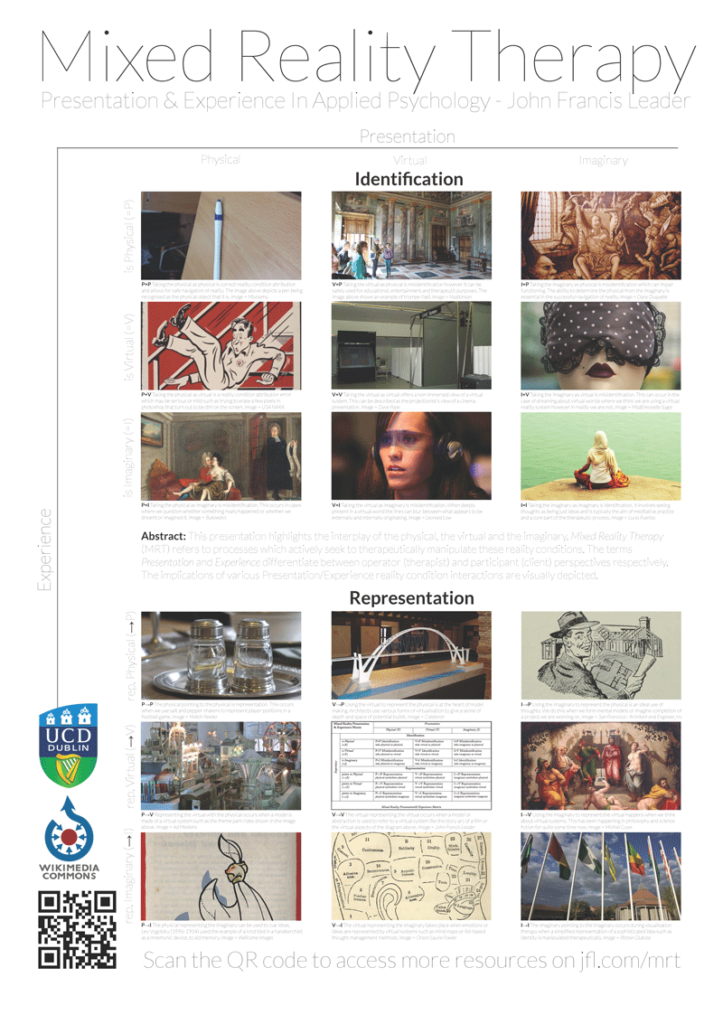Visit https://mixedrealitytherapy.org/ to find out more about the open source initiative to use experience technology to assistant with therapy, training, research and assessment
The term Mixed Reality is often used to refer to advanced and futuristic technology however in a sense all reality is mixed reality. Every day the physical, the virtual and the imaginary combine, sometimes smoothly and sometimes abruptly, to create our subjective experience. Mixed Reality Therapy refers to a variety of therapeutic approaches that recognise this interaction and seek to support participants in the successful navigation of mixed reality.
Resources
- The Presentation & Experience Gallery (see below)
- Articles (see below)
- TEDx talk on the ‘therapy of tomorrow’ by JFL
- Mixed reality experience multimedia exploration
- Mixed reality Land Rover installation video
- Talks and short audio segments on underlying themes
- Presentations and media appearances
- Podcast series exploring MRT-related concepts (audio version: Soundcloud, iTunes, Spotify, Podchaser, Stitcher, Google Podcasts)
- Social Media: Twitter, Facebook, LinkedIn, Youtube, TikTok
Articles
Google Scholar: https://scholar.google.com/citations?user=wNfuh6wAAAAJ
Leader, J. F. (2016). Mixed Reality Therapy: Presentation & Experience In Applied Psychology. Annual Review of CyberTherapy and Telemedicine, 14(1), 215-217.
Download (230kb, PDF) Academia.edu | ResearchGate
Leader, J. F. (2018). Mixed Reality Therapy Clinic Design. In 2018 IEEE Games, Entertainment, Media Conference (GEM) (pp. 1–9). IEEE. https://doi.org/10.1109/GEM.2018.8516530
Download (7,181kb, PDF) Academia.edu | ResearchGate
Leader, J. F. (2021). Normative Affordances: Utilising the constraint of context-specific expectation in simulated environments. Annual Review of CyberTherapy and Telemedicine, 2021, 21.
Download ResearchGate
The Presentation & Experience Gallery

This presentation highlights the interplay of the physical, the virtual and the imaginary. Mixed Reality Therapy (MRT) refers to processes which actively seek to therapeutically manipulate these reality conditions. The terms Presentation and Experience differentiate between operator (therapist) and participant (client) perspectives respectively. The implications of various Presentation/Experience reality condition interactions are visually depicted.
Identification
P=P Taking the physical as physical is correct reality condition attribution and allows for safe navigation of reality. The image above depicts a pen being recognised as the physical object that it is. Image = Mluisamu
V=P Taking the virtual as physical is misidentification however it can be safely used for educational, entertainment and therapeutic purposes. The image above shows an example of trompe-l’œil. Image = Nsatkinson
I=P Taking the imaginary as physical is misidentification which can impair functioning. The ability to determine the physical from the imaginary is essential in the successful navigation of reality. Image = Dany Duquefer
P=V Taking the physical as virtual is a reality condition attribution error which may be serious or mild such as trying to erase a few pixels in photoshop that turn out to be dirt on the screen. Image = USA NARA
V=V Taking the virtual as virtual offers a non-immersed view of a virtual system. This can be described as the projectionist’s view of a cinema presentation. Image = Dave Pape
I=V Taking the imaginary as virtual is misidentification. This can occur in the case of dreaming about virtual worlds where we think we are using a virtual reality system however in reality we are not. Image = MadEmoiselle Sugar
P=I Taking the physical as imaginary is misidentification. This occurs in cases where we question whether something really happened or whether we dreamt or imagined it. Image = Bukowskis
V=I Taking the virtual as imaginary is misidentification. When deeply present in a virtual world the lines can blur between what appears to be externally and internally originating. Image = Leonard Low
I=I Taking the imaginary as imaginary is identification. It involves seeing thoughts as being just ideas and is typically the aim of meditative practice and a core part of the therapeutic process. Image = Lucía Puertas
Representation
P→P The physical pointing to the physical is representation. This occurs when we use salt and pepper shakers to represent player positions in a football game. Image = Match Pewter
V→P Using the virtual to represent the physical is at the heart of model making. Architects use various forms of virtualisation to give a sense of depth and space of potential builds. Image = Caleteron
I→P Using the imaginary to represent the physical is an ideal use of thoughts. We do this when we form mental models or imagine completion of a project we are working on. Image = San Francisco : Architect and Engineer, Inc
P→V Representing the virtual with the physical occurs when a model is made of a virtual system such as the theme park rides shown in the image above. Image = Ad Meskens
V→V The virtual representing the virtual occurs when a model or abstraction is used to refer to a virtual system like the story arc of a film or the virtual aspects of the diagram above. Image = John Francis Leader
I→V Using the imaginary to represent the virtual happens when we think about virtual systems. This has been happening in philosophy and science fiction for quite some time now. Image = Michiel Coxie
P→I The physical representing the imaginary can be used to cue ideas. Lev Vygotsky (1896-1934) used the example of a knot tied in a handkerchief, as a mnemonic device, to aid memory. Image = Wellcome Images
V→I The virtual representing the imaginary takes place when emotions or ideas are represented by virtual systems such as mind maps or list-based thought management methods. Image = Orson Squire Fowler
I→I The imaginary pointing to the imaginary occurs during visualisation therapy when a simplified representation of a sophisticated idea such as identity is manipulated therapeutically. Image = Rfotsin Dubose
Discover more:
- The Presentation & Experience Gallery (see above)
- Articles (see above)
- https://mixedrealitytherapy.org/
- TEDx talk on the ‘therapy of tomorrow’ by JFL
- Mixed reality experience multimedia exploration
- Mixed reality Land Rover installation video
- Talks and short audio segments on underlying themes
- Presentations and media appearances
- Podcast series exploring MRT-related concepts (audio version: Soundcloud, iTunes, Spotify, Podchaser, Stitcher, Google Podcasts)
- Social Media: Twitter, Facebook, LinkedIn, Youtube, TikTok
